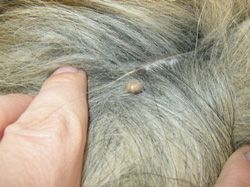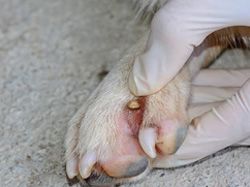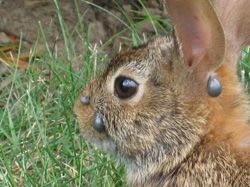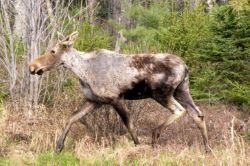Is This a Tick?
Ticks can be very small and difficult to identify. It is very easy to feel a bump, see a freckle, or find a small insect or arachnid and think that you found a tick. Below you will find several images of ticks on pets, humans, and wildlife that can help you determine if what you found is a tick. There are also tips for where to look for ticks on animals and humans to help make your tick checks more efficient. For more information about identifying different tick species, check out the Tick Identification page.
Ticks on Pets
When we pet our furry friends it is not uncommon to find a lump or a skin tag. However, it is important to inspect further to see if a strange bump could be a tick. It is important to check your pets after long hikes through thick brush, playing at a dog park, picking up your pet from a boarding kennel, and particularly after visiting other states or countries where ticks are common. If you have a cat that spends time outdoors, they may interact with small birds, rodents, and squirrels. It is possible for cats to pick up ticks from wildlife, so make it a habit to check your cat regularly for ticks after they have spent time exploring outside.


Ticks on a dog. References: Tick on Dog Image and Finding Ticks on Your Dog: 5 Places to Look.
A common place for ticks to feed is on the back of animals nestled between hair fibers, since it is a hard place for animals to scratch. Other important spots to check are between the paw pads, in their ears, on their belly, and around their tail. Ticks are drawn to warm, dark, moist areas. Comb through their fur with your fingers, pressing gently so that you can feel any bumps on the skin. Ticks can be as small as a grain of sand, or as big as a grape if they have already fed! Learn more about identifying ticks on the tick identification page. If you find a tick on your pet, follow the instructions for removing a tick safely and then submit it to the Alaska Submit-A-Tick Program to get it identified.
Ticks on Humans
Although there have only been a few reports of ticks feeding on humans in Alaska, we are still learning about the potential risk of tick exposure in our state. It is important to check yourself and your family for ticks after spending time outdoors in thick brush, interacting with wildlife, or playing with your pets. In the contiguous United States, there are several different human-biting ticks. If you are traveling to other parts of the U.S. and will be spending lots of time outside, it is important to protect yourself from ticks and check yourself, your pets, and luggage for ticks before heading back to Alaska.
Common places to check for ticks on people are around the waist, on the back of the neck, around the hairline, on the back of legs, and between toes. If you find a tick on yourself or a family member, follow the instructions for removing a tick safely and then submit it to the Alaska Submit-A-Tick Program to get it identified. Watch for signs and symptoms of tick-borne diseases and go to your healthcare provider immediately if symptoms appear.
Ticks on Wildlife
Most ticks persist in the wild by taking blood meals from wildlife. In Alaska, small mammals such as mice, voles, rabbits, and squirrels, game animals like caribou, moose, or bear, and many species of birds are often targets for ticks. You can help identify ticks on wildlife by checking hunted or trapped animals carefully in key areas on their bodies.



From left to right: Tick on an elk, bird, and rabbit. References: Winter Ticks in Yukon and Hilton Pond Center.
Ticks seek warm, dark areas to feed where they cannot be easily groomed off. You should check wildlife for ticks on their necks, around their eyes, in their ears, on their backs or bellies, and between the paw pads on mammals.
Any ticks that are found should be submitted to the Office of the State Veterinarian through the Alaska Submit-A-Tick Program. This program helps us monitor the population of native and non-native ticks in Alaska that could cause diseases in people, pets, and wildlife.
Moose Tick

Winter (moose) ticks on a moose.
Reference: Dan Bergeron, UNH.
The winter tick, or moose tick (Dermacentor albipictus), is a parasite that has been found in many parts of North America, including the Yukon Territory in Canada. These ticks can cause a significant threat to wildlife, particularly moose. Moose cannot remove these ticks during grooming and have been found with heavy infestations of thousands of ticks. These heavy infestations can cause anemia, hair loss, distraction from feeding, and ultimately death. As the climate warms, these ticks may be more likely to survive if introduced into Alaska.
You can help identify potential introductions of moose tick by turning in ticks that you find on yourself, pets, or wildlife through the Alaska Submit-A-Tick Program. But other environmental observations can also be clues to help identify moose tick in our state. If you see a moose with hair loss, please report it immediately to the Alaska Department of Fish and Game (dfg.dwc.vet@alaska.gov).

 Indicates an external site.
Indicates an external site.